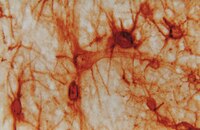Keratan sulfate proteoglycan phosphacan regulates mossy fiber outgrowth and regeneration.
Butler, Christy D, et al.
J. Neurosci., 24: 462-73 (2004)
2004
Show Abstract
We have examined the role of chondroitin sulfate proteoglycans (CSPGs) and keratan sulfate proteoglycans (KSPGs) in directing mossy fiber (MF) outgrowth and regeneration in rat hippocampal slice cultures. MFs normally exhibit a very specific innervation pattern that is restricted to the stratum lucidum (SL). In addition, MFs in hippocampal slice cultures will regenerate this specific innervation pattern after transection. CSPGs are one of the best characterized inhibitory axon guidance molecules in the CNS and are widely expressed in all areas of the hippocampus except SL. KSPGs are also widely expressed in the hippocampus, but their role in axon outgrowth has not been extensively studied in the CNS where phosphacan is the only protein that appears to contain KS-GAGs. Cultured hippocampal slices were treated with either chondroitin ABC lyase or keratanases to reduce the inhibitory axon guidance properties of CS and KS proteoglycans, respectively. The ability of transected MFs to regenerate their normal innervation pattern after digestion of CS and KS-GAGS sugars with these enzymes was examined. Only keratanase treatment resulted in misrouting of MFs. Identifying the mechanism by which keratanase produced MF misrouting is complicated by the presence of splice variants of the phosphacan gene that include the extracellular form of phosphacan and the transmembrane receptor protein tyrosine phosphatase beta/zeta (RPTPbeta/zeta). Both forms of phosphacan are made by astrocytes, suggesting that keratanase alters MF outgrowth by modifying astrocyte function. | | 14724244
 |
Receptor-mediated adhesive and anti-adhesive functions of chondroitin sulfate proteoglycan preparations from embryonic chicken brain.
Ernst, H, et al.
J. Cell. Sci., 108 ( Pt 12): 3807-16 (1995)
1995
Show Abstract
Chondroitin sulfate proteoglycans inhibit the adhesion of cells to extracellular matrix proteins that otherwise permit adhesion. Although proteoglycans are widely assumed to act by masking the other protein in a mixed substrate, recent studies suggest that proteoglycans inhibit adhesion through mechanisms initiated by their binding to specific cell surface receptors. To explore this issue, we developed a purification scheme to isolate proteoglycan aggregates, monomers, and core proteins. Two distinct adhesion assays were used to study the interaction of these proteoglycan preparations with human foreskin fibroblasts: the gravity assay in which cell attachment is stabilized by cell spreading, and the centrifugation assay in which spreading does not play a role. All proteoglycan preparations mediate adhesion in the centrifugation assay but not in the gravity assay. In the centrifugation assay, proteoglycan aggregates and monomers are considerably more active than other extracellular matrix proteins while proteoglycan core proteins are at least as active as other extracellular matrix proteins. Proteoglycan core proteins bind to cell-associated hyaluronic acid, but not to integrins. Using mixed substrates in the gravity assay, all proteoglycan preparations inhibited cell attachment to fibronectin and vitronectin but not to collagen I and laminin. Although proteoglycan aggregates and monomers are more active than core proteins in inhibiting adhesion in the gravity assay, core proteins are still clearly active. A variety of control experiments suggest that the inhibition of cell attachment by proteoglycans is mediated through the specific interactions of proteoglycans with cell surface receptors, resulting in the inhibition of cell spreading. These results suggest at least two molecular mechanisms for proteoglycan-fibroblast interactions, one involving the chondroitin sulfate on the proteoglycan and an as yet unidentified receptor, the other involving the proteoglycan core protein and cell-associated hyaluronic acid. | | 8719887
 |
The interaction of the retina cell surface N-acetylgalactosaminylphosphotransferase with an endogenous proteoglycan ligand results in inhibition of cadherin-mediated adhesion.
Balsamo, J, et al.
J. Cell Biol., 129: 1391-401 (1995)
1995
Show Abstract
We have previously shown that the binding to cells of a monoclonal antibody directed against the chick neural retina N-acetylgalactosaminylphosphotransferase (GalNAcPTase) results in inhibition of cadherin-mediated adhesion and neurite outgrowth. We hypothesized that the antibody mimics the action of an endogenous ligand. Chondroitin sulfate proteoglycans (CSPGs) are potential ligands because they inhibit adhesion and neurite outgrowth and are present in situ at barriers to neuronal growth. We therefore assayed purified CSPGs for their ability to inhibit homophilic cadherin-mediated adhesion and neurite outgrowth, as well as their ability to bind directly to the GalNAcPTase. A proteoglycan with a 250-kD core protein following removal of chondroitin sulfate chains (250-kD PG) inhibits cadherin-mediated adhesion and neurite outgrowth whether presented as the core protein or as a proteoglycan monomer bearing chondroitin sulfate. A proteoglycan with a 400-kD core protein is not inhibitory in either core protein or monomer form. Treatment of cells with phosphatidylinositol-specific phospholipase C, which removes cell surface GalNAcPTase, abolishes this inhibitory effect. Binding of the 250-kD core protein to cells is competed by the anti-GalNAcPTase antibody 1B11, suggesting that 1B11 and the 250-kD core protein bind to the same site or in close proximity. Moreover, soluble GalNAcPTase binds to the immobilized 250-kD core protein but not to the immobilized 400-kD core protein. Concomitant with inhibition of cadherin mediated adhesion, binding of the 250-kD core protein to the GalNAcPTase on cells results in the enhanced tyrosine phosphorylation of beta-catenin and the uncoupling of N-cadherin from its association with the cytoskeleton. Moreover, the 250-kD PG is present in embryonic chick retina and brain and is associated with the GalNAcPTase in situ. We conclude that the 250-kD PG is an endogenous ligand for the GalNAcPTase. Binding of the 250-kD PG to the GalNAcPTase initiates a signal cascade, involving the tyrosine phosphorylation of beta-catenin, which alters the association of cadherin with the actin-containing cytoskeleton and thereby inhibits adhesion and neurite outgrowth. Regulation of the temporal and spatial expression patterns of each member of the GalNacPTase/250-kD PG interactive pair may create opportunities for interaction that influence the course of development through effects on cadherin-based morphogenetic processes. | | 7775582
 |













